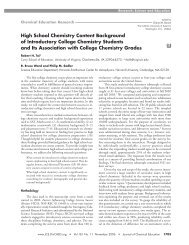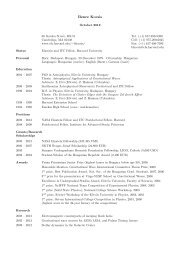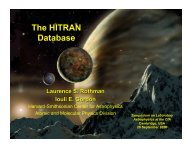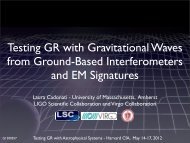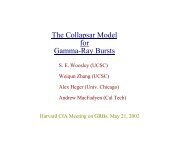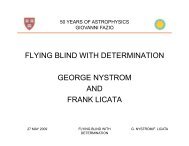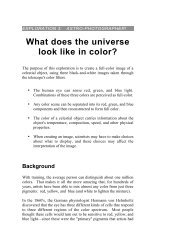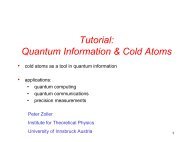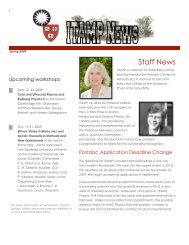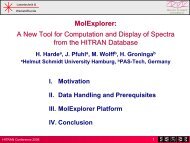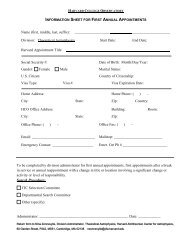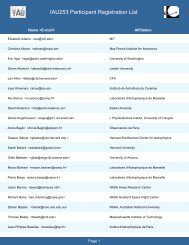Index OMC_final - Harvard University
Index OMC_final - Harvard University
Index OMC_final - Harvard University
Create successful ePaper yourself
Turn your PDF publications into a flip-book with our unique Google optimized e-Paper software.
ULTRACOLD ATOMS COUPLED TO A MICROMECHANICAL MEMBRANE<br />
David Hunger, 1,2 Stephan Camerer, 1,2 Maria Korppi, 1,2,3<br />
Andreas J ̈ockel, 1,2,3 Theodor W. H ̈ansch, 1,2 and Philipp Treutlein 1,2,3<br />
1Max-Planck-Institute of Quantum Optics, Garching, Germany<br />
2Faculty of Physics, Ludwig-Maximilians-<strong>University</strong> Munich, Germany<br />
3Department of Physics, <strong>University</strong> of Basel, Switzerland<br />
E-mail: philipp.treutlein@unibas.ch<br />
We report the observation of bi-directional coupling between a mechanical oscillator and the<br />
center-of-mass motion of ultracold atoms. Our experiment realizes a recently proposed system [1]<br />
in which an optical lattice mediates a long-distance coupling between laser-cooled atoms and a<br />
micromechanical membrane. We detect both the effect of the vibrating membrane onto the<br />
atoms as well as the effect of the atoms onto the membrane and find reasonable agreement with a<br />
simple theoretical model. Coupling ultracold atoms to mechanical oscillators opens the exciting<br />
perspective of using the tools of atomic physics to read out, cool, and coherently manipulate the<br />
oscillators’ state [2, 3, 4].<br />
Figure 1: Schematic of our setup: A laser field impinging from the right is partially reflected off a dielectric<br />
membrane and forms a standing wave optical potential for an atomic ensemble. Vibrations of the<br />
membrane’s fundamental mode will shift the standing wave field, shaking atoms in the optical lattice.<br />
Conversely, oscillations of the atomic cloud (center of mass motion) will change the intensity of left/right<br />
propagating field components, thus shaking the membrane via changing the radiation pressure on it.<br />
References:<br />
[1] K. Hammerer, K. Stannigel, C. Genes, P. Zoller, P. Treutlein, S. Camerer, D. Hunger, and T. W. H ̈ansch, Phys.<br />
Rev. A 82 021803 (R) (2010).<br />
[2] D. Hunger, S. Camerer, T. W. H ̈ansch, D. K ̈onig, J. P. Kotthaus, J. Reichel, and P. Treutlein, Phys. Rev. Lett.<br />
104, 143002 (2010).<br />
[3] P. Treutlein, D. Hunger, S. Camerer, J. Reichel, T. W. H ̈ansch, and P. Treutlein, Phys. Rev. Lett. 99, 140403<br />
(2007).<br />
[4] K. Hammerer, M. Wallquist, C. Genes, M. Ludwig, F. Marquardt, P. Treutlein, P. Zoller, J. Ye, and H. J. Kimble,<br />
Phys. Rev. Lett. 103, 063005 (2009). [4] V. M. Acosta, E. Bauch, A. Jarmola, L. J. Zipp,<br />
M. P. Ledbetter, and D. Budker, Broadband magnetometry by infrared-absorption detection of diamond NV centers<br />
[5] M.P. Ledbetter, C.W. Crawford, A. Pines, D.E. Wemmer, S. Knappe, J. Kitching, and D. Budker, Optical<br />
detection of NMR J-spectra at zero magnetic field, Journal of Magnetic Resonance 199 (2009) 25 29<br />
[6] L.-S. Bouchard, V. M. Acosta, E. Bauch, and D. Budker, Detection of the Meissner Effect with a Diamond<br />
Magnetometer<br />
12




